Has Remington finally cracked the Da Vinci code and brought us a factory M1911 that’s affordable, reliable, accurate, and a suppressor host? Our quest brings us to Remington’s modern take on a 100-year-old relic.
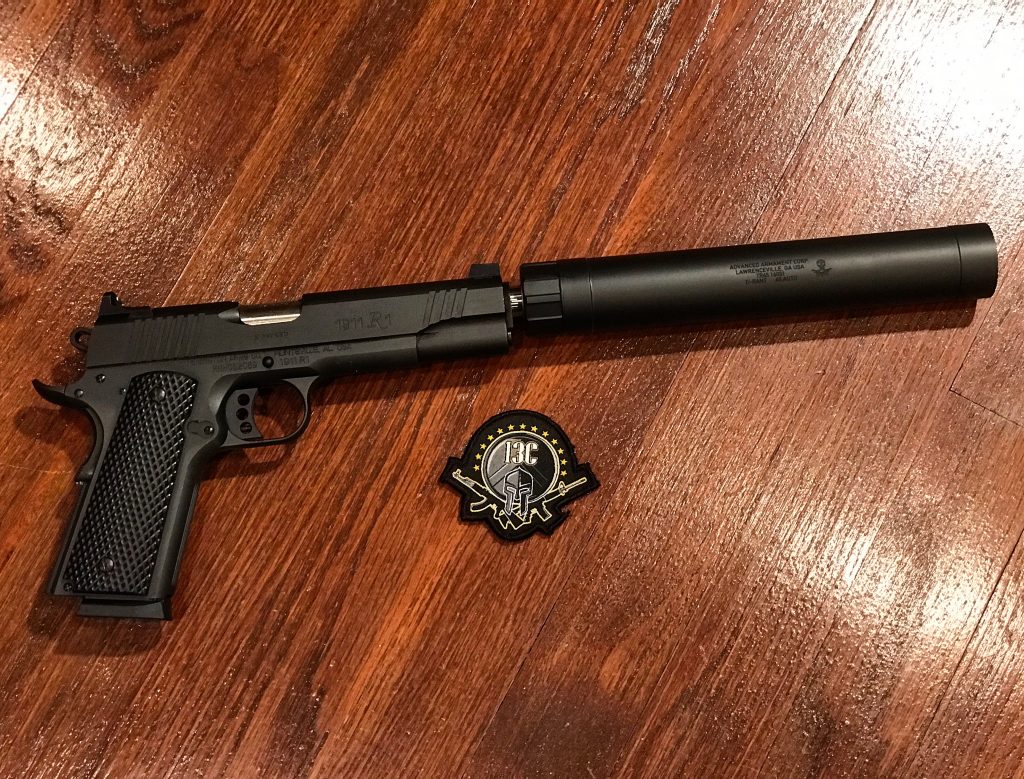
Never having been one to believe in conspiracy theories, I often wondered why I hadn’t come across a M1911 platformed handgun that was accurate, and reliable while being affordable at the same time. Affordable 1911s only seemed to reinforce the stereotype of jam-o-matics with minimal features and a diminished round capacity. A 1911 that did fill the requirement of accurate and reliable quickly grew closer in price to one month’s mortgage payment or a couple of month’s car payments. A stiff premium to pay for a working man I’d say. Wouldn’t you? Now, I know what some of you are thinking at this point. If you can afford to spend money on a suppressor, tax stamp, firearm, and ammo then financially you should be able to afford whatever it takes to get the job done right, right? In the grand scheme of things, I’d agree with you, but what if, now stay with me here, what if, someone could give you reliability, accuracy and suppressor host options all from the factory, for around half the cost compared to its next closest competitor. Would you take that deal? And that brings us to Remington’s Enhanced R1 Threaded Barrel model. In what is only a natural progression for Remington and their R1 line, they have answered the demand for factory suppressor hosts by adding a threaded stainless match barrel and extra tall sights to their already well optioned enhanced series. So, is the Enhanced R1 TB the answer to our prayers or is it another wild goose chase for the grail of value in the M1911 world? Let’s find out.
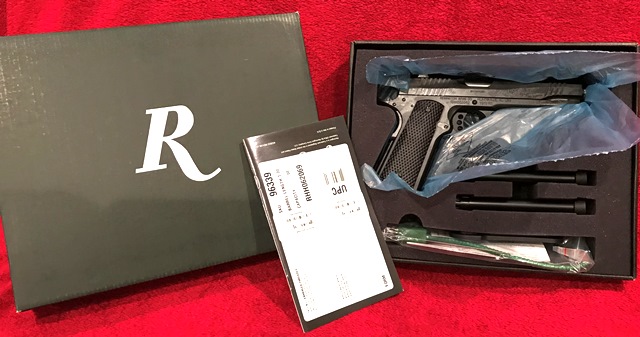
What’s In The Box
From a packaging standpoint you get a simple green box with the Remington “R” on it. Remington keeps it clean, old school, and I imagine keeps cost lower by going this route. And I’m good with It. The box, with its foam insert, does its job at getting the Enhanced R1 from Remington safely to you and housing its contents, a gun, owner manual, bushing wrench, cable lock, and two magazines. All extras were quickly placed back in the box and the box then inventoried away in my archives like the last scene in Raiders of the Lost Ark. My attention quickly turned to the magazines. Remington packages two 8 round magazines with the gun. Both have thick black plastic base pads with the “R” proudly embossed on them along with “45 Auto” just in case you forget what goes in them. What really drew my attention was the follower in the magazine. The follower itself is plastic but has a metal insert attached to the ledge that contacts the slide release and engages the slide lock feature when empty. Anyone familiar with 1911s can attest, a magazine can make or break this platform. I was now left with unpacking the Enhanced R1 Threaded Barrel from its wrapper. The Enhanced R1 was heavily oiled when I removed it, my hand was immediately saturated. No big deal to me as I would rather have to wipe off residual oil than deal with a rusted gun. The gun wiped down to reveal no visual issues from the factory. I could now begin the true assessment of the Enhanced R1.
Dissecting the R1
At first glance the Enhanced R1 is a good-looking gun that plays its role well. Except for the .578×28 threaded stainless-steel match barrel, Remington has taken the concept of stealth to every part of the Enhanced R1 by making it matte black with their oxide finish. I field stripped the gun and started my inspection with the slide. Made of forged carbon steel, it is a traditional rounded over top with front and rear side serrations. The ejection port is mildly flared and contains an internal extractor. Suppressor height sights are made of aluminium and are driven into the dovetails cut into the slide. The sights have serrations on the face of both the front and rear, are traditional notch type and have a two-dot sighting system.
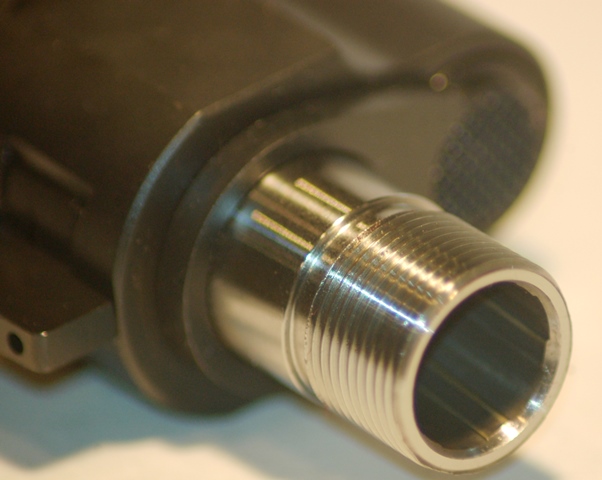
A stainless-steel match grade extended, and threaded barrel is used. The barrel, bushing, slide and link are all fit well and have virtually no play in them. Unlike other bargain 1911s, who have tremendous amounts of slop in these critical areas, I was shocked to see how well these mated. Either the planets aligned, or Remington’s QC department is keeping a close watch here. A GI length guide rod is used and in my opinion is the best choice for a 1911 set for suppressor use. It should be noted that as a “Series 80” safety style gun, the slide is cut and equipped with the appropriate parts for such.
As we make our way to the frame, the biggest area for debate will be Remington’s choice in parts manufacturing processes. While a debate in the 1911 realm, it won’t be here. Remington has chosen to use a cast carbon steel frame and MIM receiver parts. The bottom line is simple, if a casting is done properly it will yield a good part. If the MIM process is done properly it will yield a good part. In the case of this Remington I have no doubt I will get a lifetime of enjoyment from my Enhanced R1. The enhanced package from Remington allotted the installation of an extended beaver tail grip safety with a bump on its heel. The enhanced grip safety was a welcome plus but was a bit undersized and fit loosely in the frame. While the excess play ensured that no binding would occur it was noticeable enough to mention. The flat mainspring housing is plastic and sports checkering. The front strap of the frame wears 8 vertical serrations that are just deep enough to be functional without cutting into your fingers. They are very subtle and blend in well. The magazine release is a plain jane button style with 6 serrations. Again, very functional without much fan fair. The black skeletonized trigger is a three-hole design with an adjustable overtravel screw. As with the grip safety, the trigger shoe is undersized and flaps around in the track excessively. This does not affect function but will annoy a good number of shooters. The slide lock is a traditional length and the single sided safety should be considered oversized. The safety is positive and locks up well. No concerns for accidentally engaging or disengagement here, it will take some effort on your end to do either, which is a good thing. The hammer is a serrated skeletonized variant. And finally, the grips. Made from laminated wood, the checkering on these grips is beyond positive! The points on the grip come to a very sharp tip that may be too aggressive for most shooters. If you have sensitive hands be prepared with gloves or the funds to quickly replacing the grips.
Having discussed the Enhanced R1 as its two separate halves we can now discuss them as a complete firearm. When attached there is very little play in slide to frame fitment. Whether checking for play at the front of the gun or the back of the gun, it simply did not move. I then proceeded to rack the slide several times and check for play in the barrels lock up, there was none. I ended up at the muzzle and checked for play between the barrel and bushing, yet again, nothing. I was staring at an “affordable” 1911 that had just as good if not better lock up than some of the “premium” 1911s I owned. After the shock of the fitment subsided, I tried the trigger. Being a “series 80” safety style gun I was again surprised by what I was witnessing. The trigger had very little take up, no grittiness and no overtravel. I know people who have paid extra to get triggers to this point. After several pulls of the trigger I broke out the trusty Lyman trigger pull gage. The average of 10 pulls was 4.8 pounds. While the sound of that might not impress hardcore competition or bullseye shooters it should make anyone with the intent of self-defense, home defense or general target shooting ecstatic. I’m not one to get caught up in numbers when it comes to certain things. Since an individual’s perception is their reality you can only base so much on certain numbers. What I’m trying to say is don’t get caught up in reading 4.8 pounds. Instead focus on the fact that I said little take up, no grittiness and no overtravel as these parameters, in my opinion, mean much more than a unit of measure here.
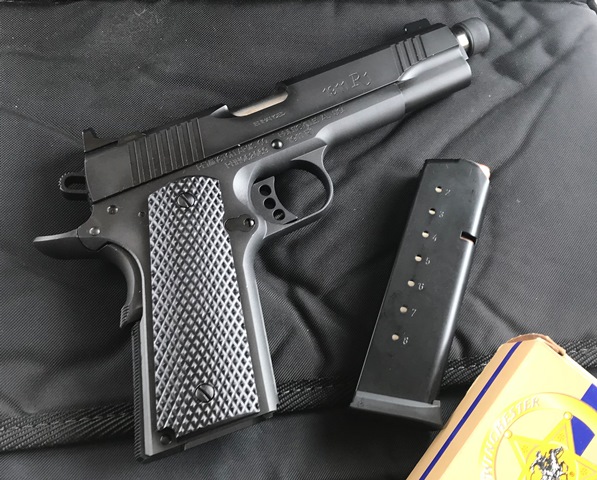
In concluding my academic appraisal of the Remington Enhanced R1 Threaded Barrel I could only gather that this particular specimen met every criteria of what a good 1911 is. Slide to frame fit was above average, barrel fitment was exceptional, barrel to bushing fit was outstanding, and trigger pull and feel superb. Even with the fitment issues in the non-critical areas described above, the Enhanced R1 displayed a value I have not seen in a 1911 ever before. But talk is cheap, and a bench top dissection can only get you so far in a real review. The real test is on the range, and in the case of the Enhanced R1 it had to pass two tests. The first as a standalone 1911 and the second as a suppressor host. As if being a 1911 isn’t hard enough these days.
Sending Lead Down Range
My first outing with the Enhanced R1 Threaded Barrel was a personal one. Consisting of its first 250 rounds, the plan was simple, take as long as needed to put all rounds down range and collet data. I don’t believe in “break in” periods or any special rituals so the only thing done in preparation for the big day was to wipe off any excess oil that came on it from the factory. With an IPSC style target set up at 15 yards I loaded up 6 rounds of Winchester Ranger 230 grain SXTs (hollow points) into one of the included magazines, inserted, chambered, took aim and fired. With only three rounds fired I experienced my first malfunction, a double feed.
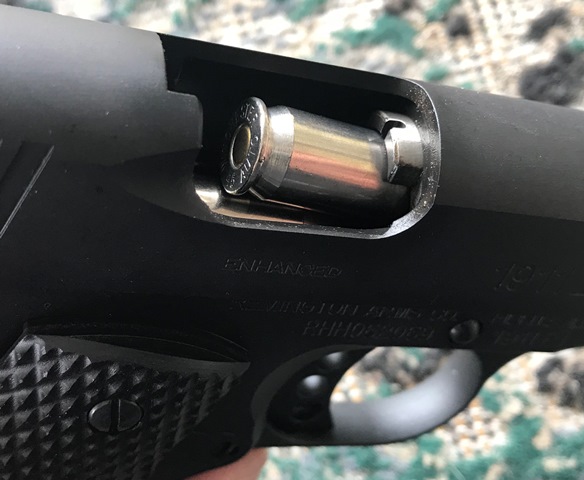
I quickly cleared the stoppage and loaded the same magazine again, with three rounds in it, chambered and fired. Malfunction again! Suffering from it’s second double feed I could only think one thing, this is going to be a long day. After clearing the gun for the second time I loaded the two remaining rounds and fired. No malfunctions and the gun achieved slide lock. Having been aiming at a hand drawn two-inch circle on the target, all five rounds hit high and left within the A zone. I then loaded the second magazine that came with the R1 with another 6 rounds of the hollow points. This time two round got off before a double feed. I cleared and reloaded the remaining four, fired once, and had a double feed. Having experienced three malfunctions in less than two magazines and 9 rounds I was done. Before allowing frustration to set in I cleared the R1 and loaded the remaining two hollow points along with five more, for a total of seven, into one of three 15 plus year-old Wilson Combat magazine I had on hand. All 7 rounds fired with no issues and slide lock was achieved after the final round, as should. Not dismissing the factory magazines just yet, I loaded each with eight rounds of 185 grain semi wadcutter ammo. Magazine one fired all without issue while magazine two had a double feed after the first round. I was now officially done with the two OEM supplied magazines. After packing away the two magazines I loaded 21 rounds of 185 grain semi wadcutters into the three Wilson magazines. All fired with no issues. For the rest of the shooting session I experienced no other malfunction. After discontinuing use of the problem inducing OEM magazines the R1 ran like a swiss watch.
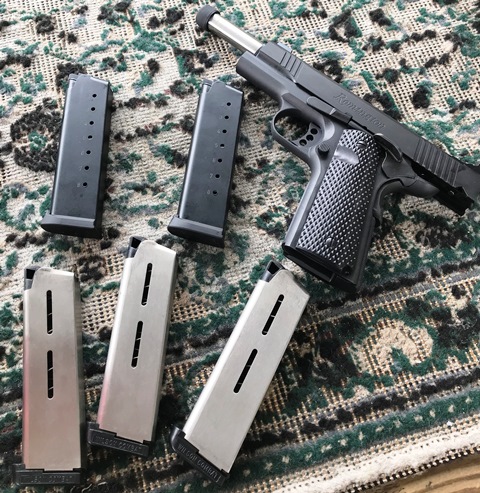
With a mixed diet of hollow points, semi wadcutters and ball ammunition there was no arguing this was a shooter. What seemed to be a day destined to drag on quickly became one that went by too soon. The R1 was more than capable of taking down 8-inch steel plates at 25 yards while producing sub 3-inch rapid fire groups at 15 yards. After exhausting my supply of ammo, I packed up the R1 and headed home knowing that I’d have more than enough opportunity to put it through its paces over the next few weeks.
My next outing with the R1 brought it to a training session with the Police Department that I work for. As a trainer I thought what better way to test the R1 than to let several shooters of varying skill sets try it out. For some officers this was the first time they would ever fire a 1911, and for others the first time firing suppressed. With a diet strictly of 230 grain ball ammunition fed from three old Wilson Combat magazines, the R1 was fired 250 time over 3 days by 11 officers while wearing an AAC TiRant 45 suppressor. The gun ran flawless with zero malfunctions. Officers with little or no experience were hitting 12”x12” steel at distances up to 50 yards with little effort. I asked for feedback and three points kept being brought up. The first was the amazement that they could fire .45acp without hearing protection. There was more curiosity as to how quiet the gun was than anything else. The second was how the gun felt in their hands. Many said they expected the gun to be nose heavy with the long suppressor attached but were surprised that it wasn’t. Many comments were made abut how heavy the gun is, they all carry 9mm Glocks, but many also stated it was a manageable weight. The third point was the recoil, or should I say lack thereof. With preexisting stereotypes of a heavy recoiling round and platform combination many were quick to compare the jolt of the suppressed R1 to that of their duty 9mm guns. After the last day of training I was very content with the performance of the R1. With 500 rounds down the barrel, both suppressed and unsuppressed, I couldn’t ask for more up to this point but knew that its hardest test was yet to come.
The R1’s third and final test took us to the range with 13c himself. With homefield advantage we would double team the R1 with over 400 rounds of a mixed bag of ammunition and the use of an AAC TiRant 45 and a Gemtech GM-45 suppressor. In a three-hour time span, having been shot both suppressed and unsuppressed, the only time we encountered a malfunction was when the gun was reintroduced to the OEM Remington magazines. No matter what ammunition was used, the OEM magazines would double feed at some point. Again, the OEM magazines were taken out of rotation and all stoppages ceased. With most of our shooting done on steel at varying distances, the R1 did not disappoint.
The Final Word
With a street price of around $650, Remington’s Enhanced R1 Threaded Barrel is a bargain in the realm of 1911s and a steal when you factor in the suppressor host options. After putting over 900 rounds through it, the R1 easily earned our respect regarding reliability. With no cleaning between range sessions, a variety of ammunition used and combined with the grime that comes with suppressor use the R1 never failed us. We can’t completely dismiss the fact that the two OEM magazines provided induced malfunctions, but we also won’t hold the gun itself accountable for them. From a reliability standpoint the R1 did what many 1911s can’t do, and that was run.
When it came to fit and finish the R1 held its own against competitors with steeper price tags and less features. It’s matte black finish and overall appearance make the R1 a visually intimidating firearm. With tight fitment in critical areas such as slide to frame, and barrel lock up we couldn’t help but accept the loose-fitting grip safety and trigger as they did not hamper performance. The sub 5-pound trigger broke clean with little take up and overtravel, something I was very impressed with here. As a suppressor host, the barrel’s .578×28 pitched threads were cut clean and sharp making attaching cans simple. From a sighting standpoint the aluminum construction of the front and rear sights may not be as robust as some may like but we found it more than adequate for our needs. The extra tall sights cleared both our suppressors with ease and made zeroing in on targets effortless.
So where does that leave us? Well, while I won’t say this was a miracle, I will say Remington has produced one of the best factory 1911 suppressor hosts available today. When you consider the price of the Enhanced R1 Threaded Barrel, factor in all it’s features and recognize it’s real world performance you can’t help but become a believer.



